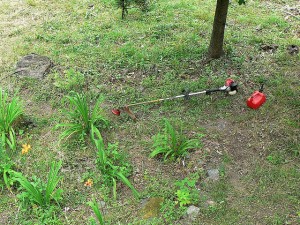
Weeding and feeding your lawn doesn’t take long, and they don’t require a large amount of expensive tools and products. Best of all these practices tend to have quick results, unlike some lawn treatments that take months for results to show.
Remove weeds from your lawn and garden
Unwanted plants that pop up in your lawn may just seem like an annoyance, but they’re actually much more. Weeds can strangle the roots of grass and even small trees. Dandelions, crabgrass, and honeysuckles are all considered invasive plants. There are a few ways that you can get rid of weeds in your lawn, but the method that you use greatly depends on the time of year and the current presence of weeds.
The most effective way to prevent weeds from popping up is to apply pre-emergent weed treatments. These pre-emergent treatments eliminate the chance of these plants popping up, unless the roots have already appeared. If the window for pre-emergent treatments has passed, a post-emergent pesticide or manual weeding will be required.
Post-emergent pesticides can be spread in your lawn once weeds have started springing up. The solution required for this type of lawn treatment can be found at all major home improvement stores, and application is as easy as spreading the solution throughout your lawn, following the directions found on the package.
If you’re avoiding the use of chemicals in your lawn weeds can be manually removed. This can be done by simply pulling the plants out of the ground, holding them firmly at the base in hopes of removing the root along with the exposed part of this plant. This method takes more time than others, and pulling these weeds up will not necessarily prevent more from growing back.
A healthy lawn is a well fed one
Like everything else, grass grows best when it is properly fed. Grass thrives when exposed to the nutrients found in fertilizer and water. There are many types of fertilizer available on the market, and while fertilizing your lawn is easy it isn’t a task that should be performed without prior research and preparation.
Step 1, Check your soil: Before you fertilize your lawn it is essential that test the pH level of the soil. The pH level indicates how alkaline or acidic your soil is, measured on a scale from 1 (most acidic) to 14 (most basic, or alkaline), with 7 being neutral. If the results are skewed toward one side or another you’ve probably already started seeing the effects of this imbalance. Lime and sulfur treatments are the two most common ways of remedying an imbalance in your soil, but if you have recurring problems you may want to consider adding plants that can naturally correct these pH issues. You can also use organic matter to help naturally change the pH level. Applying compost and mulch are two great ways to gradually lower the pH level of your soil.
Step 2, Select a fertilizer: Once you’re sure that the pH level of your soil is balanced you can begin fertilization practices. Fertilizers are available in many forms, including both solid and liquid varieties. Avoid using fertilizers that have a high phosphorus content, these types of products are only required in newly seeded lawns. The best type of fertilizer for you depends on many factors, including geographic conditions and soil types. Speak with a lawn expert in your area about the best fertilizer for the conditions in your area.
Step 3, Time the application: Even if the pH level of your soil indicates that it’s safe to fertilize your lawn it doesn’t mean the time of year is right. In most parts of the United States, fertilization is best in mid- to late-spring, before the rainy summer season begins. In states where the winter is warm enough for grass to survive the winter fertilization should take place in the fall.
Step 4, Spread fertilizer: There are many methods for spreading fertilizer, but drop spreaders and cyclone spreaders are two of the most effective tools for the job. Simply fill the basin of this device with your fertilizer to begin the process. Then push the spreader in straight lines, alternating directions and slightly overlapping each time. Fertilizer can also be spread by hand, but achieving uniform results is much more time-consuming.